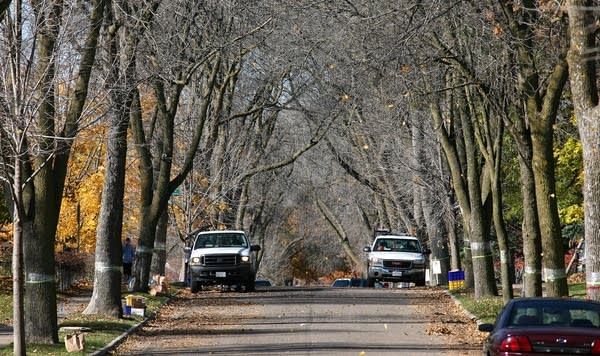St. Paul takes emerald ash borer battle to the streets
Go Deeper.
Create an account or log in to save stories.
Like this?
Thanks for liking this story! We have added it to a list of your favorite stories.

It was a taste of what's to come for other neighborhoods, as the city fights back against the Emerald ash borer, when people on a street in St. Paul, not far from the Fairgrounds, watched their ash trees coming down Wednesday.
Three crews from St. Paul's Parks and Recreation Department are orchestrated a blitz on two whole blocks of towering, mature green ash trees.
"They're 60 years old, they look pretty bad, branches have been falling down," said resident Loretta Hoffman. "I'm sort of glad they're going, it'll be nice to have young trees here, and we won't have as many leaves to rake anymore."
Hoffman said she and her neighbors seem pretty philosophical about the loss of their trees. Peter Andersen does have some regrets.
Turn Up Your Support
MPR News helps you turn down the noise and build shared understanding. Turn up your support for this public resource and keep trusted journalism accessible to all.
"It's a shame because this was really a beautiful street, it was very tree-lined with a lot of foliage, it was very nice with the canopy," Andersen said. "It's a shame that one bug does this to all our trees."
The cutting routine is one guy up in a cherry picker with a chainsaw cuts off a limb and it crashes down to the ground. Somebody on the ground comes with another chainsaw, cuts it up and stacks it on the street, and a city truck picks up the limbs and branches with a pincher, and putting it in the back of big dump truck.

"We are going to go into areas of the city where we find declining trees, remove them, remove the stumps, and replant," said city forestry technician Rachel Coyle. "That's just so that we're ahead of it; ahead of Emerald ash borer and ahead of the possible destruction and what could happen if there are thousands of dead trees standing."
Coyle is working on St. Paul's multi-pronged plan to deal with EAB. She calls this part of the campaign "structured removal."
These trees aren't necessarily infested with Emerald ash borer. They aren't even close to the St. Anthony Park neighborhood, where the flying pest was found six months ago.
In that neighborhood, most of the trees will stay to contain the infestation.
"If we remove all of the ash trees from the area, it's only going to make the EAB search further for ash trees to feed on and to live in, so keeping trees in that area is pretty important," Coyle said.
Instead, in infested areas, they'll girdle some trees -- take the bark off a section -- to weaken them. It's a pretty sneaky attack on the insect.
"The thought is that the stressed-out ash attracts the females, and so they lay their eggs on those trees, the larva infest those trees, and then we take the trees out before the larvae turn into beetles, and you reduce the population," she said.

That strategy works pretty well: eight out of ten trees that were girdled in the summer and cut last month were infested. Other girdled trees are being held over until spring, so U of M researchers can see whether a good Minnesota winter does any damage to the larvae.
There's a further refinement of that girdling strategy. I the infested areas, they'll girdle some trees and treat others nearby with insecticide.
"If the females are attracted to the girdled tree, but they end up going to a treated tree instead, right next to it, then they'll still die," Coyle said.
Last week, the pest was found in Langford Park, about three-fourths of a mile from the original discovery site.
Scientists have figured out the beetles infested the original trees in 2006, possibly even earlier. The beetles can spread up to a mile a year.
On Friday, the city will plant young Redmond Lindens and Sienna Glen Maples on these two blocks.
In the meantime, these once-graceful relics are heading to Pig's Eye landing. They'll be chipped there and then burned at the District Energy plant in downtown St. Paul. Trees that provided shade for homes last summer will help keep the downtown warm this winter.




